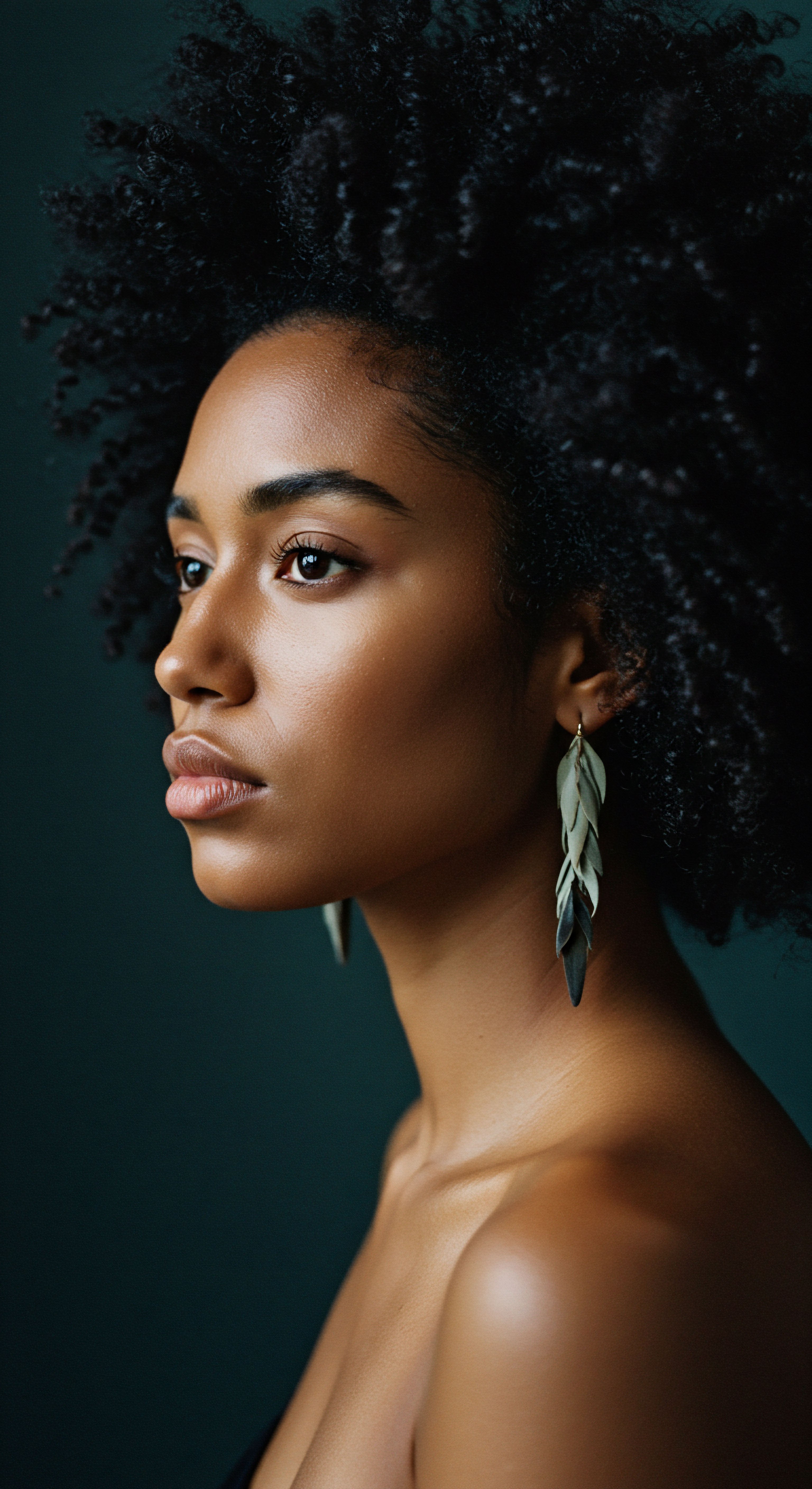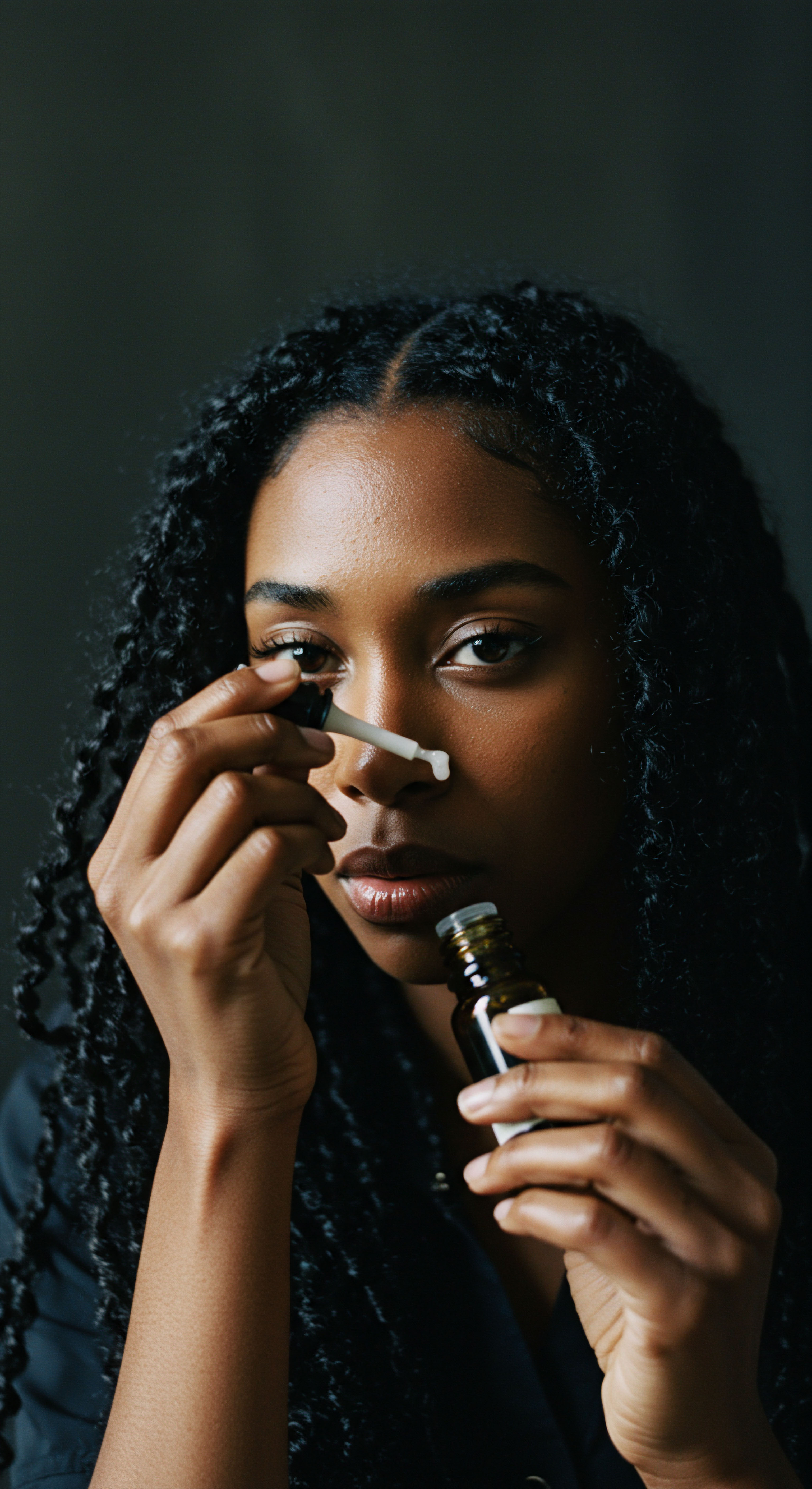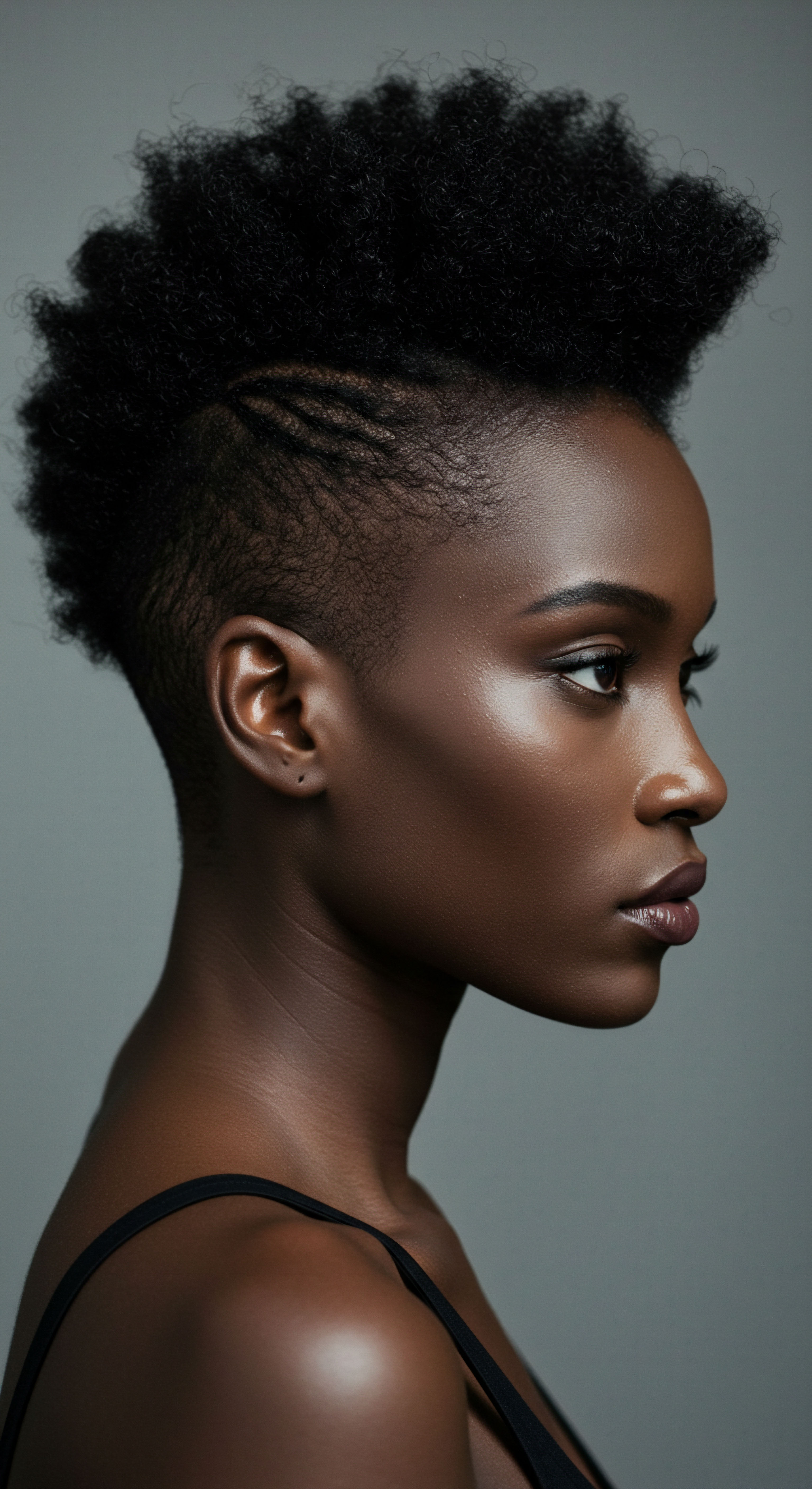
Roots
In the quiet hours, as the world settles into slumber, our hair, too, engages in a silent exchange with its surroundings. For those of us with textured strands, this nightly interaction carries a particular weight, often determining the ease of our mornings and the vitality of our curls, coils, or waves. We consider the intimate relationship between our hair and the fabrics it rests upon, seeking to understand how different materials shape its very essence. The inquiry into how silk compares to cotton for hair hydration is not merely a question of comfort; it reaches into the foundational understanding of our hair’s structure and its intrinsic need for moisture.

Hair’s Thirst A Structural Inquiry
The hair shaft, a marvel of biological engineering, possesses a complex architecture designed for both strength and flexibility. At its outermost boundary lies the Cuticle, a protective layer of overlapping, scale-like cells, much like shingles on a roof. Beneath this lies the Cortex, which gives hair its strength and color, and at the core, the medulla, though not all hair types possess one. Hair’s ability to retain moisture, its hydration, hinges significantly on the integrity of this cuticle layer.
When these scales lie flat and smooth, they seal in the precious internal moisture, reflecting light and lending a healthy sheen. Conversely, when the cuticle is raised or damaged, moisture escapes more readily, leaving hair vulnerable to dryness and breakage. This delicate balance of internal water and external protection defines hair health. The hair fiber itself is composed primarily of proteins, making up 80-85% of its weight, along with lipids and water.

Textile Fiber Fundamentals
To truly appreciate the interplay between hair and fabric, one must consider the microscopic world of textiles. Cotton, a natural cellulose fiber, is known for its absorbency. Under a microscope, cotton fibers appear as flattened, twisted ribbons with a relatively rough surface. This rougher topography, while excellent for absorbing liquids like water, can also create friction.
Silk, by contrast, is a natural protein fiber, spun by silkworms. Its individual strands are remarkably smooth, long, and uniform, presenting a surface with significantly less friction. This fundamental difference in surface texture and chemical composition dictates how each material interacts with the delicate outer layer of our hair.
Understanding the inherent structures of hair and the fabrics it encounters is the initial step toward preserving moisture.

The Microscopic Dance of Hair and Fabric
When hair encounters a surface, a subtle dance of friction and moisture exchange begins. Cotton, with its more textured surface, can cause microscopic snagging and tugging on the hair’s cuticle. This mechanical interaction can lift the cuticle scales, leading to increased porosity and a greater potential for moisture loss.
The absorbency of cotton means it can also draw moisture directly from the hair strand, acting like a tiny sponge. This absorption, while beneficial in a towel, becomes a disadvantage when aiming to preserve hair hydration overnight.
Silk, on the other hand, presents a smoother glide. The low friction coefficient of silk allows hair to move across its surface with minimal resistance, helping to keep the cuticle scales lying flat. This reduced mechanical stress is paramount for textured hair, which is inherently more prone to dryness and breakage due to its unique curl patterns and the challenges these patterns pose for natural oil distribution.
- Hair Cuticle ❉ The outermost protective layer, vital for moisture retention.
- Cotton Fibers ❉ Characterized by a rougher, absorbent surface.
- Silk Fibers ❉ Distinguished by their smooth, protein-based structure.

Ritual
The quiet moments we dedicate to our hair, particularly as day turns to night, hold a profound significance. These rituals, often performed in the gentle glow of a bedside lamp, are not merely acts of maintenance; they are affirmations of care, wisdom passed down, and a deep understanding of our hair’s unique needs. As we prepare for sleep, the choice of what our hair rests upon becomes a silent yet powerful part of this nightly tradition. It is here, in the practical application of knowledge, that the distinct qualities of silk and cotton truly reveal themselves in the ongoing pursuit of hair hydration.

Nightly Care And Fabric’s Role
The hours spent sleeping represent a significant period for hair interaction with its environment. For many, this means contact with a pillowcase. Cotton pillowcases, while ubiquitous and comfortable, can be surprisingly detrimental to hair health, particularly for those with curls, coils, or delicate strands.
The absorbent nature of cotton readily wicks away moisture from the hair, including natural oils and applied products, leaving strands parched by morning. This can lead to increased dryness, a common concern for textured hair, which often struggles with retaining moisture.
In contrast, silk’s less absorbent nature means it leaves hair’s natural hydration largely undisturbed. This difference is particularly noticeable in the morning; hair that has rested on silk often feels softer and appears less tangled, retaining more of its natural luster. The practice of using silk for nighttime hair protection is a tradition rooted in a practical understanding of hair’s needs, predating modern science.

Minimizing Friction How Materials Perform
Beyond moisture absorption, the mechanical friction generated by pillowcases plays a substantial part in hair damage. Cotton’s rougher texture creates more resistance as hair moves against it during sleep. This constant rubbing can lift the hair’s cuticle, leading to frizz, split ends, and breakage. Studies on friction’s impact on hair have long highlighted the importance of surface smoothness.
Silk, with its exceptionally smooth surface, dramatically reduces this friction. Hair glides over silk, minimizing snagging and preserving the cuticle’s integrity. This reduction in mechanical stress is a cornerstone of silk’s reputation for promoting healthier hair. It allows hair to retain its natural shape and definition, reducing the need for excessive manipulation in the morning.
Nightly choices of fabric, whether cotton or silk, profoundly shape hair’s hydration and integrity, transforming rest into a restorative act.

The Practical Impact of Fabric Choice
Consider the morning ritual. Waking with tangled, frizzy hair often necessitates more detangling, more product application, and potentially more mechanical stress. A study published in 2023, assessing changes in hair structure after different drying processes, highlighted how even cotton towel drying can contribute to hair damage and increased mechanical wear. Extending this principle to overnight contact, the cumulative effect of cotton friction can be considerable.
Choosing silk pillowcases or bonnets becomes a simple yet effective strategy to mitigate these daily challenges. It is a proactive step in preserving the hair’s delicate balance, allowing styling efforts and moisturizing products to work more effectively. This seemingly small shift in material can yield significant benefits for the long-term health and appearance of textured hair.
| Property Moisture Absorption |
| Cotton High, wicks moisture from hair |
| Silk Low, allows hair to retain moisture |
| Property Surface Texture |
| Cotton Rougher, can cause friction |
| Silk Smooth, reduces friction |
| Property Impact on Frizz |
| Cotton Increases potential for frizz |
| Silk Helps minimize frizz |
| Property Hair Breakage |
| Cotton Higher risk due to friction |
| Silk Lower risk due to reduced friction |
| Property Cuticle Integrity |
| Cotton Can lift cuticle scales |
| Silk Helps keep cuticle scales flat |
| Property These distinctions underscore why silk is often favored for hair care. |

Relay
Stepping beyond the immediate observations of hair’s interaction with fabric, we find ourselves at a deeper confluence where molecular science, historical practices, and cultural wisdom intersect. The question of how silk truly surpasses cotton for hair hydration beckons us to consider not just surface-level differences, but the profound biochemical and physical mechanisms at play. This is where the nuanced conversation begins, a relay of understanding from the microscopic world of protein structures to the broader context of hair care traditions that have endured across generations.

The Biophysical Mechanics of Hydration
Hair hydration is not merely about water sitting on the surface; it involves water molecules interacting with the hair’s internal protein structure, primarily keratin. Hair’s ability to absorb water is a function of its polarity, allowing water molecules to form hydrogen bonds with protein sites within the hair fiber, causing it to swell and increase in diameter. The outer cuticle layer, rich in lipids, particularly 18-methyl eicosanoic acid (18-MEA), provides a hydrophobic surface that acts as a boundary lubricant, reducing friction between hair fibers. When this layer is compromised, hair becomes more hydrophilic, increasing friction and making it prone to dryness.
Cotton, a cellulosic fiber, is highly hygroscopic, meaning it readily absorbs and holds water from its surroundings. While this property makes cotton excellent for towels, it means it can actively draw moisture away from hair, especially during prolonged contact like sleep. This competitive absorption of moisture can leave hair depleted of its essential water content and natural oils.
Silk, a protein fiber composed mainly of fibroin and sericin, behaves differently. These proteins possess amino acid structures that allow them to interact with water, but silk itself is less absorbent than cotton. Instead of soaking up moisture from the hair, silk tends to allow hair to retain its own hydration, acting as a smoother, less disruptive surface. The sericin protein in particular has been noted for its moisturizing efficacy and ability to form a protective layer, helping to prevent moisture loss.

Does Fabric Choice Impact Hair Porosity?
The relationship between fabric and hair extends to hair porosity, a critical factor in how textured hair manages moisture. Hair porosity refers to how well your hair’s cuticle layer allows moisture to enter and escape the hair shaft. Low porosity hair has tightly bound cuticles, making it difficult for moisture to penetrate but also for it to escape. High porosity hair, often a result of damage, has raised or compromised cuticles, allowing moisture to enter and leave easily, leading to dryness.
Cotton’s abrasive surface can contribute to raising the cuticle scales, particularly on hair already predisposed to damage. This can exacerbate issues for high porosity hair, making it even more challenging to maintain hydration. For low porosity hair, while less prone to immediate moisture loss, the increased friction can still lead to mechanical damage over time, potentially altering its cuticle structure and increasing its susceptibility to moisture imbalance. Silk’s smooth surface, by minimizing friction and cuticle disturbance, helps to maintain the existing integrity of the hair’s cuticle, regardless of its porosity level, thereby supporting its natural hydration mechanisms.
The subtle differences in textile composition lead to profound shifts in hair’s moisture balance and structural integrity.

A Controversial Consideration Is All Friction Equal?
While the consensus points to silk’s superiority in reducing friction, some perspectives challenge the blanket assumption that all friction is detrimental or that the “smoothness” of silk is the sole factor. A study by Schwartz and Knowles in 1963, a classic in hair science, first highlighted how friction from combing and contact with various materials can wear down the hair cuticle. However, more recent research on hair friction, often using advanced microscopy techniques, reveals the complexity of these interactions.
For instance, some studies on hair drying conditions, using techniques like Fourier transform infrared (FTIR) microscopy, have investigated changes in hair keratin structure due to mechanical wear from different towels, including cotton. This suggests that the type of friction, the duration of contact, and the state of the hair (wet or dry) all play a part.
The often-cited statistic that cotton can cause “up to 50% more hair breakage” compared to smoother fabrics, as some sources claim, is compelling. While the exact percentage can vary based on hair type, condition, and specific cotton weave, the underlying principle of reduced mechanical stress on silk is consistently supported by studies on hair cuticle damage. Research using atomic force microscopy (AFM) has shown that healthy hair has a smooth appearance due to its cuticle cells, which limit friction between hair fibers.
Damage to this epicuticle layer, including the loss of 18-MEA, increases surface friction. Therefore, any material that preserves this delicate outer layer will inherently support better hair health and hydration.
- Hair Porosity ❉ Influences how hair absorbs and releases moisture.
- 18-MEA ❉ A crucial lipid on the hair’s surface reducing friction.
- Protein Fibers ❉ Silk’s composition contributes to its gentle interaction with hair.

Cultural Reverence for Hair Protection
Beyond the scientific data, cultural practices across the globe have long recognized the significance of protecting hair, often employing materials that mirror the benefits of silk. From ancient China, where silk production originated around 2700 BC, to India and the Arabian Peninsula, silk hair wraps were used to protect hair from environmental elements like dust and sun, maintain styles, and even signify social status. Persian women used silk wraps to shield their hair from harsh desert climates, while in Japan, traditional “kazashi” wraps, often silk, adorned and protected elaborate hairstyles.
These historical precedents speak to an intuitive understanding of silk’s protective qualities long before modern microscopy could reveal cuticle damage. The enduring legacy of silk in hair care rituals, particularly within cultures that celebrate diverse hair textures, underscores a collective wisdom regarding moisture preservation and mechanical integrity. This cultural wisdom, now corroborated by scientific inquiry, reinforces silk’s role as a superior choice for maintaining hair hydration and health.
| Aspect Cuticle Surface |
| Hair's Natural State Smooth, lipid-coated (18-MEA) |
| Cotton Interaction Rougher contact, lifts scales |
| Silk Interaction Smooth glide, preserves scales |
| Aspect Moisture Exchange |
| Hair's Natural State Retains internal water |
| Cotton Interaction Actively absorbs water from hair |
| Silk Interaction Allows hair to retain its own water |
| Aspect Friction Coefficient |
| Hair's Natural State Low (healthy hair) |
| Cotton Interaction Higher, increases mechanical stress |
| Silk Interaction Lower, minimizes mechanical stress |
| Aspect Protein Interaction |
| Hair's Natural State Keratin-based structure |
| Cotton Interaction Minimal beneficial interaction |
| Silk Interaction Protein-based, gentle affinity |
| Aspect Silk's protein structure and smooth surface align with hair's natural protective mechanisms. |

Reflection
As we journey through the intricate world of hair and its interaction with the materials we choose, a clear narrative unfolds. The whispered wisdom of generations, advocating for the gentle caress of silk, finds its echo in the precise language of scientific observation. Our hair, a living extension of our identity and heritage, thrives when treated with understanding and respect for its delicate balance. The distinction between silk and cotton, in this context, extends beyond a mere comparison of fabrics; it becomes a contemplation of how conscious choices, however small, can contribute to the enduring vitality and serene beauty of our textured strands.

References
- Schwartz, A. M. & Knowles, D. C. (1963). Frictional Effects in Human Hair. Journal of the Society of Cosmetic Chemists, 14, 449-459.
- Bouillon, C. & Wilkinson, J. (Eds.). (2005). The Science of Hair Care (1st ed.). CRC Press.
- Biddle-Perry, G. & Harlow, M. (Eds.). (2018). A Cultural History of Hair, Volume 1 ❉ A Cultural History of Hair in Antiquity. Bloomsbury Academic.
- Sakamoto, K. Lochhead, R. Y. Maibach, H. I. & Yamashita, Y. (Eds.). (2017). Cosmetic Science and Technology ❉ Theoretical Principles and Applications. Elsevier.
- Jude, Y. (2009). The Black Hair Care Revolution ❉ A Simple Pocket Guide to Growing & Maintaining Healthy Natural & Permed Hair. Aardvark Global Pub.
- Sherrow, V. (2006). Encyclopedia of Hair ❉ A Cultural History. Greenwood Press.
- Tinoco, A. Costa, A. F. Luís, S. Martins, M. Cavaco-Paulo, A. & Ribeiro, A. (2021). Proteins as Hair Styling Agents. Applied Sciences, 11(9), 4245.
- Robbins, C. R. (2012). Chemical and Physical Behavior of Human Hair (5th ed.). Springer.
- Bhushan, B. & Kwak, D. (2014). Friction Dynamics of Straight, Curly, and Wavy Hair. Journal of the Royal Society Interface, 11(94), 20131109.
- Kuwata, O. Suzuki, K. & Miyake, K. (2013). Degradation of Hair Surface ❉ Importance of 18-MEA and Epicuticle. Cosmetics, 1(1), 1-14.